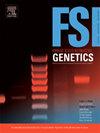利用韩国人和欧洲人发现的标记物进行基于DNA甲基化的精液年龄预测
IF 3.1
2区 医学
Q2 GENETICS & HEREDITY
引用次数: 0
摘要
在法医领域,性侵犯一直是一个重要问题,精液经常被作为主要证据。当嫌疑犯身份不明时,通过调查精液来估计犯罪者的年龄可以提供重要的信息。VISAGE联盟对欧洲精液样本进行了年龄预测研究,但年龄预测模型仍未公开。此外,一些研究报告了不同人群的甲基化差异,这表明欧洲精液年龄预测模型可能并不广泛适用于其他群体。一项研究确实使用Illumina的Infinium Methylation450K BeadChip阵列探索了韩国人的精液年龄预测,但最近的技术发展可以增强这种方法。为了解决这个问题,我们对18-70岁的韩国男性进行了一项研究。我们首先使用Illumina公司的Infinium MethylationEPIC头芯片阵列分析了49个样本,以确定与年龄相关的CpG位点。从这项分析中,我们确定了9个与年龄相关的CpG标记,其中一个由于基因座特异性分析困难而被排除。因此,我们使用了11个标记,包括8个来自EPIC阵列的新鉴定的CpG和3个来自先前研究的CpG标记。此外,我们结合了来自欧洲研究的13个CpG标记,使用Illumina Nextera MPS系统分析了总共159份精液样本。这种方法使我们能够在韩国人口中测试欧洲人发现的年龄相关标记,并利用韩国和欧洲的标记构建更准确的年龄预测模型。本文章由计算机程序翻译,如有差异,请以英文原文为准。
DNA methylation-based semen age prediction using the markers identified in Koreans and Europeans
In the forensic field, sexual assaults have consistently been the important issue, with semen frequently serving as the primary evidence. When the suspect is unidentified, estimating the perpetrator’s age using investigating semen can provide important information. The VISAGE consortium conducted research on the semen age prediction focused on European semen samples, but the age prediction model has remained undisclosed. Additionally, several studies have reported methylation differences across populations, indicating that the European semen age prediction model might not be broadly applicable to other groups. A study did explore semen age prediction in Koreans using Illumina’s Infinium Methylation450K BeadChip array, however recent developments in technology could enhance this approach. To address this, we conducted a study on Korean males aged 18–70 years. We initially analyzed 49 samples utilizing Illumina’s Infinium MethylationEPIC BeadChip array to identify age-related CpG sites. From this analysis, we identified 9 age-related CpG markers, excluding one due to difficulties in locus-specific analysis. As a result, we used 11 markers including 8 newly identified CpGs from the EPIC array and 3 CpG markers from previous research utilizing the SNaPshot assay. Furthermore, we incorporated 13 CpG markers from the European study to analyze a total of 159 semen samples using the Illumina Nextera MPS system. This approach enabled us to test age-related markers identified in Europeans within the Korean population and to construct a more accurate age prediction model using markers from both Korean and European sources.
求助全文
通过发布文献求助,成功后即可免费获取论文全文。
去求助
来源期刊
CiteScore
7.50
自引率
32.30%
发文量
132
审稿时长
11.3 weeks
期刊介绍:
Forensic Science International: Genetics is the premier journal in the field of Forensic Genetics. This branch of Forensic Science can be defined as the application of genetics to human and non-human material (in the sense of a science with the purpose of studying inherited characteristics for the analysis of inter- and intra-specific variations in populations) for the resolution of legal conflicts.
The scope of the journal includes:
Forensic applications of human polymorphism.
Testing of paternity and other family relationships, immigration cases, typing of biological stains and tissues from criminal casework, identification of human remains by DNA testing methodologies.
Description of human polymorphisms of forensic interest, with special interest in DNA polymorphisms.
Autosomal DNA polymorphisms, mini- and microsatellites (or short tandem repeats, STRs), single nucleotide polymorphisms (SNPs), X and Y chromosome polymorphisms, mtDNA polymorphisms, and any other type of DNA variation with potential forensic applications.
Non-human DNA polymorphisms for crime scene investigation.
Population genetics of human polymorphisms of forensic interest.
Population data, especially from DNA polymorphisms of interest for the solution of forensic problems.
DNA typing methodologies and strategies.
Biostatistical methods in forensic genetics.
Evaluation of DNA evidence in forensic problems (such as paternity or immigration cases, criminal casework, identification), classical and new statistical approaches.
Standards in forensic genetics.
Recommendations of regulatory bodies concerning methods, markers, interpretation or strategies or proposals for procedural or technical standards.
Quality control.
Quality control and quality assurance strategies, proficiency testing for DNA typing methodologies.
Criminal DNA databases.
Technical, legal and statistical issues.
General ethical and legal issues related to forensic genetics.

 求助内容:
求助内容: 应助结果提醒方式:
应助结果提醒方式:


